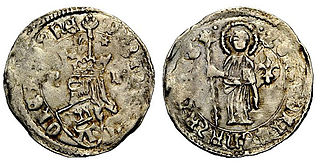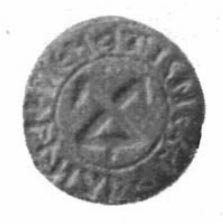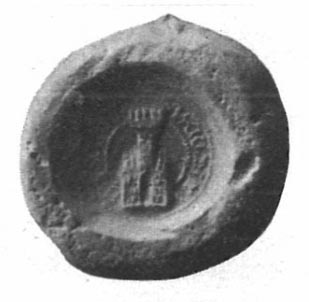Nikolić noble family
Last updatedThis article needs additional citations for verification .(September 2016) |
| Nikolić | |
|---|---|
 | |
| Country | Kingdom of Bosnia |
| Founded | after 1363 |
| Titles | Knez, duke |
| Estate(s) | |
| Dissolution | 1453 (last mention) |
Nikolić noble family was Bosnian medieval noble family from Hum (later Herzegovina), today Bosnia and Herzegovina. The family's estate was in western part of the Bosansko Primorje (transl. Bosnian Coast), namely Popovo Polje and Neum. They were of minor importance, serving under Grand Dukes of Bosnia and noble families of Hranić and Kosača, lords of Hum and later Herzegovina.
Contents
History
The progenitor of the family was Nikola, a župan or knez. [1] [ better source needed ] Nikola had two sons by Katarina, the daughter of Stephen I, Ban of Bosnia: Vladislav and Bogiša. [2]
Little is known about the first ancestors of the Nikolić family, though they were most likely important family in Hum, with princess Vukosava, Petar and Miliša Nikolić probably being the second generation of the Nikolić family. The first mention of the Nikolić brothers happened after the death of King Tvrtko I of Bosnia in 1391. Loyal to the new Bosnian king, Stephen Dabiša, they were granted Republic of Dubrovnik citizenship by 1392. After ascension of the rival king to Bosnian Kingdom throne, namely Stephen Ostoja, the Nikolić brothers, also related to Queen Jelena Gruba who was of the House of Nikolić herself and widow of Stephen Dabiša, were forced to take refuge in Dubrovnik. Later Vukosav participated in the Bosnian-Ragusan War around 1403 as a nobleman of the Grand Duke of Bosnia Sandalj Hranić, and was killed and was buried in Ston on 28 November 1403.
Grgur Vukosalić, the son of Vukosav Nikolić, was present at historical events in Bosnia in the course of Tvrtko II's campaign against King Stephen Ostoja and his own lord and Grad Duke of Bosnia, Sandalj Hranić. To no avail the Nikolić family tried to gain independence from the Bosnian duke, and after Hranić's death they remained loyal to his successor as the Grad Duke of Bosnia, Stjepan Vukčić Kosača, as well. Grgur died in July 1436.
The sons of Grgur Vukosalić, Vuk and Vukašin Grgurević, maintained their position under Stjepan Vukčić Kosača, as the Grand Duke tried to overtake Zeta. In 1442 Vukasin fell into Venetian captivity, but with Dubrovnik help he was released. The last mention of the Nikolić family was in 1453, and they were still under the lordship of Stjepan Vukčić Kosača. The Ottoman Empire had already entered area of Vrhbosna and prepared conquest of rest of the Bosnian Kingdom, which will occur 10 years later. Finally, after decades of political and social instability, Bosnia officially fell in 1463. Herzegovina would follow in 1482, with a Hungarian-backed reinstated Bosnian state around former capital Jajce being the last to succumb in 1527. After the end of Bosnian medieval state, Nikolić's fate is little known until the 18th century.
Members
- Family tree
- Nikola, knez (župan)
- Vladislav (fl. 1347–1363)
- Vukosav Nikolić (fl. 1395–d. 1403),
- Grgur Nikolić (fl. 1403–d. 1436), knez
- Vuk Nikolić
- Vukašin Nikolić
- Radoje Nikolić, vojvoda
- Grgur Nikolić (fl. 1403–d. 1436), knez
- Vukosav Nikolić (fl. 1395–d. 1403),
- Bogiša (fl. 1347–1363)
- Vladislav (fl. 1347–1363)
- Unknown genealogy
- Jovan
- Bogdan
- Miliša (fl. 1392)
- Jelena Gruba (ca. 1345–d. after March 18, 1399), Queen of Bosnia from 1391 to 1398, first as queen consort until 1395 and then as queen regnant.
Related Research Articles

The House of Kotromanić was a late medieval Bosnian noble and later royal dynasty. Rising to power in the middle of the 13th century as bans of Bosnia, with control over little more than the valley of the eponymous river, the Kotromanić rulers expanded their realm through a series of conquests to include nearly all of modern-day Bosnia and Herzegovina, large parts of modern-day Croatia and parts of modern-day Serbia and Montenegro, with Tvrtko I eventually establishing the Kingdom of Bosnia in 1377. The Kotromanić intermarried with several southeastern and central European royal houses. The last sovereign, Stephen Tomašević, ruled briefly as Despot of Serbia in 1459 and as King of Bosnia between 1461 and 1463, before losing both countries – and his head – to the Ottoman Turks.

Hrvoje Vukčić Hrvatinić was a medieval Bosnian nobleman and magnate, Grand Duke of Bosnia, Knyaz of Donji Kraji, and Duke of Split. He was the most prominent member of the Hrvatinić noble family, and one of the major feudal lords in Kingdom of Bosnia. He was Grand Duke of Bosnia under three Bosnian kings: King Tvrtko I, King Stephen Dabiša and King Stephen Ostoja. In 1403 Ladislaus of Naples named him his deputy for Dalmatia, and bestowed him with a title Duke of Split, later Herzog of Split. He played a crucial role in the dynastic struggles between the Anjou and Luxembourg claimants to the Hungarian-Croatian throne at the end of the 14th century, as well as in the emergence of the Bosnian Kingdom as a regional power during the same period.
Helen, also known by the name Gruba/Груба, ruled the Kingdom of Bosnia from September 1395 until late April or early May 1398. She was queen consort as the wife of King Dabiša, and was chosen by the stanak to rule after his death. Whether she was a regent who ruled during an interregnum or a queen regnant is disputed, but in any case the real power was held by magnates of the kingdom. Her rule ended with the election of King Ostoja.
Stephen Ostoja was King of Bosnia from 1398 to 1404 and from 1409 to 1418.

The House of Hrvatinić was a Bosnian medieval noble family that emerged in Donji Kraji county, located in today's territory of western Bosnia and Herzegovina. Principally they were vassals to Kotromanić dynasty of the Banate of Bosnia and Kingdom of Bosnia, occasionally also to the Kingdom of Hungary, changing loyalties between Hungarian kings Ladislaus of Naples and Sigismund of Luxembourg, and finally the Ottoman Empire (1472–1476). They rose to prominence in the second half of the 14th century, and attained its peak under magnate Hrvoje Vukčić Hrvatinić (1350–1416), who also held large swaths of Dalmatia and obtained title of Grand Duke of Bosnia in 1380.

Stephen Tvrtko II, also known as Tvrtko Tvrtković, was a member of the House of Kotromanić who reigned as King of Bosnia from 1404 to 1409 and again from 1420 to his death.

The House of Kosača, somewhere Kosačić, was a Bosnian medieval noble family which ruled over parts of modern-day Bosnia and Herzegovina, Croatia, Montenegro, and Serbia between the 14th century and the 15th century. The land they controlled was known as Humska zemlja, roughly corresponding to modern region of Herzegovina, which itself was derived from the title "Herzog", which Stjepan Vukčić Kosača adopted in 1448., with latin title "Dux Sancti Sabbae". Besides Hum, they ruled parts of Dalmatia and Rascia. They were vassals to several states, including the Kingdom of Bosnia and Ottoman Empire. Historians think the Kosača family is part of the Kőszegi family, but there is a lack of evidence for this claim.
The religious confession of the Kosača family is uncertain. They were in contact with the Eastern Orthodox Church, the Church of Bosnia, the Roman Catholic Church and Islam. During the fall of the Bosnian Kingdom, the "Kosače" split into three branches: Venetian, Dalmatian and Ottoman. From then onward, these branches became accepting of the Roman Catholic faith, in the first two cases, and of Islam in the third.

The Sanković family was a powerful Bosnian noble family active in the 14th and start of the 15th century in Hum, serving the Serbian and Bosnian monarchies. Their seat was in Glavatičevo, where the family burial place is also located, and their estates included Nevesinje and Popovo Polje in what is today Herzegovina and Konavle in southern Dalmatia.

Radič Sanković was powerful Bosnian nobleman and magnate in the Kingdom of Bosnia during the reign of Stephen Dabiša (1391-1395) and Queen Helen (1395-1398). He allied himself with usurper Stephen Ostoja (1398-1404) during the civil wars, until his death in 1404. With the title of vojvoda, he held territories in present-day Herzegovina, including Župa Valley with Glavatičevo as its center, Nevesinje, parts of Popovo Polje and most of Konavle.
Sandalj Hranić Kosača was a powerful Bosnian nobleman whose primary possessions consisted of land areas between Adriatic coast, the Neretva and the Drina rivers in Bosnia, and served the court as the Grand Duke of Bosnia sometime between 1392 and his death in 1435, although the first mention as a Grand Duke in sources comes from 16 June 1404. He was married three times, but had no children. After his death, he was succeeded by his nephew Stjepan Vukčić Kosača.

Herzegovina is the southern and smaller of two main geographical regions of Bosnia and Herzegovina, the other being Bosnia. It has never had strictly defined geographical, cultural or historical borders, nor has it ever been defined as an administrative whole in the geopolitical and economic subdivision of Bosnia and Herzegovina.

Stjepan Vukčić Kosača was a powerful Bosnian nobleman who was politically active from 1435 to 1465; the last three decades of Bosnian medieval history. During this period, three kings acceded to the Bosnian throne: Tvrtko II, Thomas (Tomaš), Stephen Tomašević (Stjepan Tomašević) and anti-king Radivoj—the older brother of King Thomas—before the country was conquered by the Ottomans.

The Kingdom of Bosnia, or Bosnian Kingdom, was a medieval kingdom that lasted for nearly a century, from 1377 to 1463, and evolved out of the Banate of Bosnia, which itself lasted since at least 1154.

Pavle Radinović, sometimes Radenović,, was one of the most powerful Bosnian nobleman under Tvrtko I, Dabiša, Jelena Gruba, Ostoja, Tvrtko II and Ostoja again. He was a knez and the head of Radinović-Pavlović noble family, a powerful magnate clan whose initially possessions spread from central to eastern Bosnia, gravitating around the Prača - Miljacka river axis, between the Krivaja Drina and the Upper Bosna rivers, with the seat in Borač and Pavlovac between Prača and Rogatica, and also held mines in Olovo and Fojnica.
Vukosav Nikolić was mid-ranking Bosnian nobleman and a vassal to Kosača-Vukčić family under Sandalj Hranić, who served the Kingdom of Bosnia during the reign of his relative Jelena Gruba and Stephen Ostoja ,. He was the lord of Neum, the Popovo field, and the Lower Neretva region. He fell in battle during the Bosnian-Ragusan War (1403).
Bosnian–Ragusan War (1403–1404), sometimes called Second Bosnian–Ragusan War, was a military conflict fought between the Kingdom of Bosnia and the Republic of Ragusa between 1403 and 1404, which ended with a treaty signed officially in 1405. In 1403 Stephen Ostoja of Bosnia sided with King Ladislaus of Naples in his plights against the Hungarian King Sigismund, Bosnia's liege. King Ostoja led a war against the Ragusans, Sigismund's allies.
Vukac Hranić Kosača was powerful Bosnian magnate and nobleman from Kosača noble family with the title of knez, during the reigns of Tvrtko II, Stephen Ostoja, Stephen Ostojić and Tvrtko II again.
Vrsinje was a medieval župa, at times part of the Kingdom of Serbia, the Kingdom of Bosnia, and briefly, as a nahiya of the Ottoman Empire. It was a county in the land of Travunija. After the Ottoman conquest, it was replaced by the Zupci.
Radoslav Pavlović, sometimes spelled Radislav, or Radosav, was a Bosnian nobleman of the noble family Pavlović-Radinović. He inherited title of knez from his father Pavle Radinović upon his father death, while his older brother Petar (1415–1420), being the first in order of precedence, was bestowed a title of duke by the Bosnian throne. He and his brother also inherited their father's estates in the eastern parts of the Kingdom of Bosnia. After the murder of his father Pavle Radinović on Parena Poljana, near Sutjeska and Bobovac, in 1415 by the hand of Grand Duke of Bosnia, Sandalj Hranić (1392–1435), Radosav together with his older brother Peter, started a war against Sandalj Hranić and his Kosača clan, as those responsible for the murder. After the death of his older brother Petar in the conflict with the Ottomans in 1420, Radosav assumed leadership over the Pavlović's clan and took over the title of duke, and around 1421 he was bestowed a title of Grand Duke of Bosnia by the throne. He ended the conflicts with the Kosača and sealed the peace with a marriage with the daughter of Vukac Hranić, princess Teodora, the sister of the future Kosača's clan chieftain, Stjepan Vukčić (1435—1466), with whom he had three sons. In 1426, he sold his part of Konavle to the Republic of Ragusa for 18,000 perpers, but in 1430 he started the so-called First Konavle War over the sold territories, which ended in 1432 with the recognition of the situation from the beginning of the conflict. In 1435, after the death of Duke Sandalj Hranić, he tried to take advantage of the new situation, but in a conflict with his wife's brother Stjepan, he eventually lost the southern parts of his zemlja around Trebinje. He died in 1441, and was succeeded by his son Ivaniš Radoslavić Pavlović (1441—1450).
Petar I Pavlović was a knez, and then a Grand Duke of Bosnia, from the noble family of Pavlović, which had its possessions in the eastern parts of the Kingdom of Bosnia. After the murder of his father Pavle Radinović on Parena Poljana near royal court in Sutjeska and below a Bobovac in 1415, after the stanak at which whole Pavlović family was present at, Petar took over the leadership of the Pavlovići and with his younger brother Knez Radosav (1420–1441) started a war against Sandalj Hranić (1392–1435) and Kosača klan. In that conflict, he relied on the help of the Ottomans, whose help he paid for by recognizing vassal relations to the sultan, which also resulted in successful campaigns against Sandalj, who was completely suppressed. However, the Ottomans changed sides and arrived in the Kingdom of Bosnia in 1420 as Sandalj's allies against Pavlović. In the conflict with them, Petar himself was killed, and his younger brother Radosav succeeds him as the leader of Pavlović and the Grand Duke of Bosnia.
References
- ↑ Ljubo Mihić (1975). Ljubinje sa okolinom. Dragan Srnic. p. 798.
- ↑ Herta Kuna (1974). Starija književnost. Zavod za izdavanje udžbenika. p. 93.